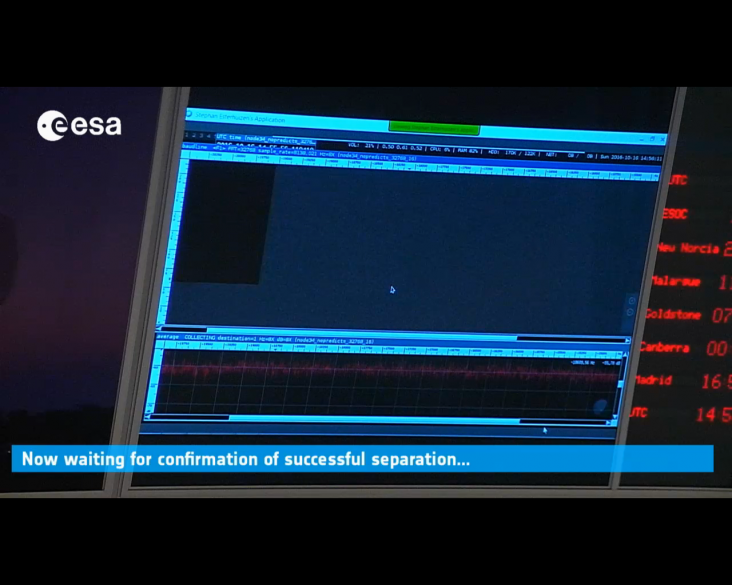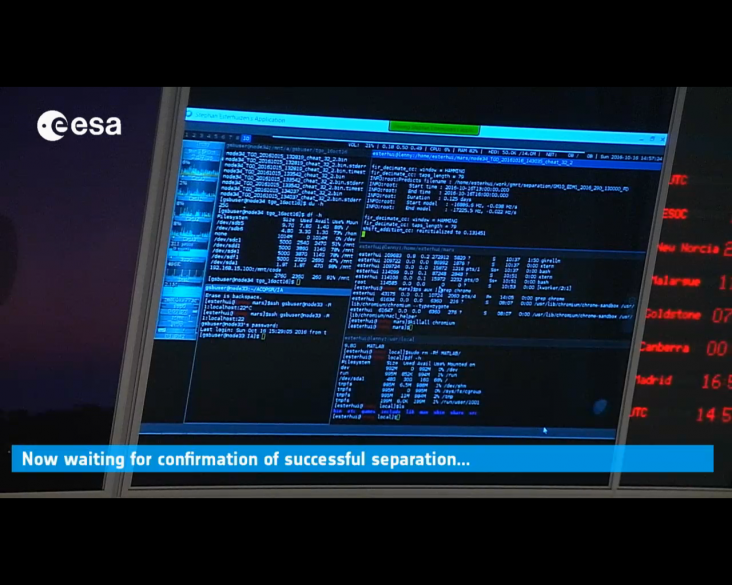Live: Landing van Schiaparelli op Mars (ESA)
This Wednesday, Oct. 19th, a European Space Agency (ESA) probe named "Schiaparelli" will parachute to the surface of Mars following a fiery plunge through the atmosphere. Launched from Earth last March, Schiaparelli hitched a ride to Mars onboard the Trace Gas Orbiter, a satellite that will spend the next few years scanning the Red Planet for chemical signs of life--especially biogenic methane. Follow the action on the ESA's live webcast.
http://www.spaceweather.com/

photo ESA
One of the core scientific goals of any mission to Mars is the search for evidence of life. The best approach is to investigate the surface where the evidence may lie.
The key element for accessing the surface of Mars and one of the greatest challenges in space exploration is the successful execution of the entry, descent and landing sequence.
This is one of the reasons why since the late 1960s there have been so many missions attempting to landon the surface of Mars, some being successful, many others ill-fated.
Schiaparelli - an entry, descent and landing demonstrator module - is a technology demonstration vehicle carried by the ExoMars Trace Gas Orbiter (TGO). Schiaparelli and TGO were launched on 14 March 2016 on a Proton rocket from the Baikonur cosmodrome in Kazakhstan. Schiaparelli will demonstrate the capability of ESA and European industry to perform a controlled landing on the surface of Mars. The preparation for this mission enhances Europe’s expertise and enables the testing of key technologies which could be used in subsequent missions to Mars.
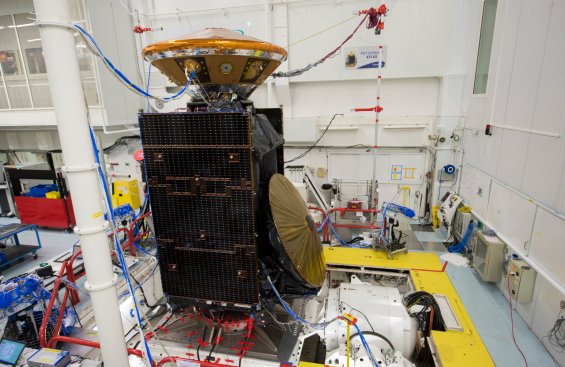
Photo ESA
Although designed to demonstrate entry, descent and landing technologies, Schiaparelli also offers limited, but useful, science capabilities. It will deliver a science package that will operate on the surface of Mars for a short duration after landing, planned to last approximately 2-4 sols (Martian days).
ARRIVING AT MARS
Schiaparelli has started its journey to Mars attached to the Trace Gas Orbiter. They were launched on a Proton rocket on 14 March 2016 and will arrive approximately 7 months later at Mars.
COAST
Three days before reaching the atmosphere of Mars, on 16 October, Schiaparelli separated from the Orbiter.
The module is now coasting to Mars during which phase it will remain in hibernation mode in order to reduce its power consumption.
Schiaparelli will be activated a few hours before entering the atmosphere of Mars, at an altitude of 122.5 km and a speed of approximately 21 000 km/h.
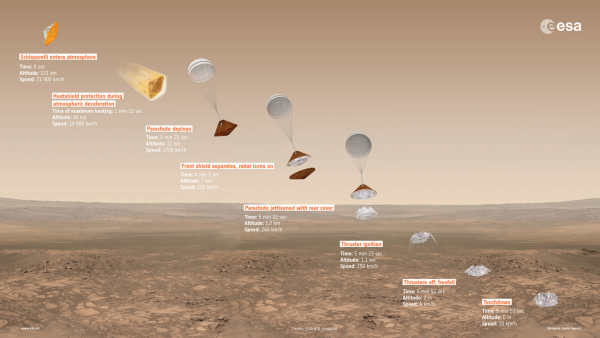
ENTRY
An aerodynamic heatshield will protect Schiaparelli from the severe heat flux and deceleration, so that at an altitude of about 11 km, when the parachure is deployed, it will be travelling at around 1650 km/h.
DESCENT
The module will first release the front heatshield and then the rear heatshield will also be jettisoned.
Schiaparelli will turn on its Doppler radar altimeter and velocimeter to locate its position with respect to the Martian surface.
LANDING
The liquid propulsion system will be activated to reduce the speed to less than 7 km/h when it is 2m above the ground. At that moment the engines will the switched off and the lander will drop to the ground.
As Schiaparelli lands, the final shock will be cushioned by a crushable structure built into module.
The primary landing site has been identified: it is a plain known as Meridiani Planum. This area interests scientists because it contains an ancient layer of hematite, an iron oxide that, on Earth, almost always forms in an environment containing liquid water.
A communication link between Schiaparelli and the Trace Gas Orbiter will facilitate the real-time transmission of the most important data measured by the module. The complete set of data acquired will be transmitted to the Orbiter within 8 sols after the landing (a solar day on Mars, or sol, is 24 hours and 37 minutes).
Descent and landing at a glance
- Three days before reaching Mars, on 16 October, Schiaparelli separated from the Trace Gas Orbiter and is now coasting towards the planet in hibernation mode, to reduce its power consumption.
- Schiaparelli will be activated a few hours before entering the atmosphere of Mars at an altitude of 122.5 km and a speed of 21 000 km per hour.
- An aerodynamic heatshield will slow the lander down such that at an altitude of about 11 km, when the parachute is deployed, it will be travelling at around 1650 km per hour.
- Schiaparelli will release its front heatshield at an altitude of about 7 km and turn on its radar altimeter, which can measure the distance to the ground and its velocity relative to the surface. This information is used to activate and command the liquid propulsion system once the rear heatshield and parachute have been jettisoned 1.3 km above the surface.
- At this point, Schiaparelli will still be travelling at nearly 270 km per hour, but the engines will slow it to less than 7 km per hour by the time it is 2 m above the surface.
- At that moment, the engines will be switched off and Schiaparelli will free-fall to the ground, where the final impact, at just under 11 km per hour, will be cushioned by a crushable structure on the base of the lander.
- Schiaparelli will arrive at Mars during the global dust storm season, which means that it may encounter a highly dust-loaded atmosphere.
- The heat shield surface temperature during entry reaches approximately 1500°C.
- The landing is controlled but not guided, and the module has no obstacle avoidance capability
- Schiaparelli will target a landing site on the plain known as Meridiani Planum
- Schiaparelli will be designed to be capable of landing on a terrain with rocks as high as 40 cm and slopes as steep as 12.5°.
Schiaparelli builds on a heritage of designs that have been evaluated and tested by ESA during earlier ExoMars studies. The module accommodates a series of sensors that will monitor the behaviour of all key technologies during the mission. These technologies include a special material for thermal protection, a parachute system, a radar Doppler altimeter system, and a braking system controlled by liquid propulsion. The data will be sent back to Earth for post-flight reconstruction in support of future European missions to Mars.
The main characteristics of Schiaparelli are provided in the table below:
Main technical characteristics of Schiaparelli – the ExoMars Entry, Descent and Landing Demonstrator Module
- Diameter /Height 2.4 m with heatshield, 1.65 m without heatshield 1.8 m high
- Mass 577 kg (wet)
- Heat shield material Norcoat Liège
- Structure Aluminium sandwich with Carbon Fiber Reinforced Polymer skins
- Parachute Disk-Gap-Band canopy, 12 m diameter
- Propulsion 3 clusters of 3 hydrazine engines (400 N each), operated in pulse-modulation
- Power Primary batteries
- Communications UHF link with the ExoMars Orbiter (with 2 antennas)
SCHIAPARELLI SCIENCE AND ENGINEERING SENSORS
Because Schiaparelli is primarily demonstrating technologies needed for landing, it does not have a long scientific mission lifetime: it is intended to survive on the surface for just a few days by using the excess energy capacity of its batteries. However, a set of engineering and scientific sensors will analyse the local environment during descent and after landing.
Schiaparelli carries a small science payload, called DREAMS (Dust Characterisation, Risk Assessment, and Environment Analyser on the Martian Surface), to study the environment. DREAMS consists of a suite of sensors to measure the local wind speed and direction (MetWind), humidity (DREAMS-H), pressure (DREAMS-P), atmospheric temperature close to the surface (MarsTem), the transparency of the atmosphere (Solar Irradiance Sensor, SIS), and atmospheric electric fields (Atmospheric Radiation and Electricity Sensor; MicroARES) at Mars. The payload will operate on the surface of Mars for 2–8 sols.
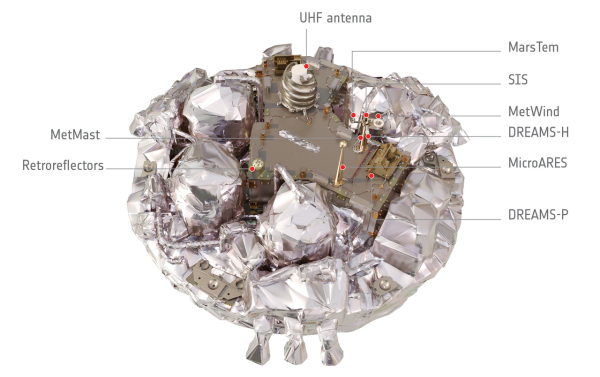
Photo ESA
In addition, there is an investigation known as AMELIA, for entry and descent science data collection using the spacecraft engineering sensors.
A separate instrumentation package, COMARS+, will monitor the heat flux on the back cover of Schiaparelli as it passes through the atmosphere.
A compact array of laser retroreflectors, called INRRI, is attached to the zenith-facing surface of Schiaparelli. This can be used as a target for Mars orbiters to laser-locate the module.
Read more about Schiaparelli's science studies here.
Bron: http://exploration.esa.int/mars/47852-entry-descent-and-landing-demonstrator-module/
Event starts Wed, Oct 19 2016 5:40 PM http://livestream.com/ESA/marsarrival
| Gewijzigd: 1 februari 2017, 09:28 uur, door Joyce.s
Wat gaat er gebeuren:
Three days before arriving at Mars on 19 October 2016, the ExoMars Trace Gas Orbiter (TGO) will release its entry, descent and landing demonstrator, Schiaparelli, towards the Red Planet.
ExoMars is several missions in one. Its orbiter is a science and relay mission. TGO will search for evidence of gases, such as methane, that may be associated with geological or biological processes. The Schiaparelli lander is a technology demonstrator to test key technologies for future missions to Mars.
The landing site is an elliptical region close to the equator about 100 km long and 15 km wide in the planet’s Meridiani Planum area. It is relatively flat, smooth and well studied because NASA’s Opportunity rover is on the ground and ESA’s Mars Express spacecraft, which will also act as one of the data relay orbiters, has been overhead since 2003.
This film covers the landing and orbital manoeuvres, including the use of aerobraking - which ESA is using for the first time at Mars. It contains soundbites from Michel Denis, ExoMars Flight Operations Director, and Johannes Bauer, ExoMars Spacecraft Operations Engineer.
Bron: http://www.esa.int/spaceinvideos/Videos/2016/10/ExoMars_at_the_Red_Planet
Lot van Marslander Schiaparelli onduidelijk
Het is niet duidelijk of de Europese poging een apparaat op Mars te laten landen is gelukt. De lander moest vandaag na aankomst een signaal naar de vluchtleiding in het Duitse Darmstadt sturen. Dat had daar rond 17.00 uur Belgische tijd moeten aankomen, maar Darmstadt heeft nog niets gehoord.
Het uitblijven van het signaal kan betekenen dat de landing is mislukt, maar een andere mogelijkheid is dat het signaal te zwak is. Op een andere manier probeert de ESA alsnog zekerheid te krijgen. In de loop van de avond moet het lot van de lander duidelijk worden.
Satelliet
De operatie was onderdeel van een dubbele ruimtemissie van de European Space Agency (ESA). Vandaag plaatste zij een satelliet in een baan rond de rode planeet en liet de zogenoemde ExoMars landen. Om 16.48 uur Nederlandse tijd moest de robot zachtjes op het oppervlak ploffen.In de afgelopen maanden zijn de robot en de satelliet samen naar Mars gevlogen om onder meer de dampkring van onze buurplaneet te onderzoeken. De missie wordt uitgevoerd met Rusland. De landing van robot Schiaparelli op Mars was afgelopen middag via een livestream te volgen.
Missie
De satelliet die ESA in een baan rond Mars lanceert, heet de Trace Gas Orbiter en speurt vooral naar methaan, een gas dat kan wijzen op minieme vormen van leven. Om in een baan rond Mars te komen, moet de satelliet zo hard afremmen dat hij wordt gegrepen door de zwaartekracht van de planeet. Dat remmen begon om 15.04 uur Belgische tijd en duurt ruim twee uur.
Bron: hln.be | Gewijzigd: 1 februari 2017, 09:29 uur, door Joyce.s
Een dag van vreugde gecombineerd met onzekerheid
Gisteren was het dan zover, de Marslanding. Het zou een dag worden van wachten, nagelbijten, vreugde en weer nagelbijten.De missie was tweeledig:
- de TGO (The Trace Gas Orbiter) in een baan om Mars brengen;
- Schiaparelli laten landen op Mars (Schiaparelli is een testvoertuig voor de missie die in 2020 staat gepland, als we daadwerkelijk een rover op Mars willen laten landen).

"We" konden verder met de missie. Deze zou "iets" langer gaan duren dan vooraf voorzien was. Normaal gesproken zou Schiaparelli rond 5 uur gaan landen op de Marsbodem.
Volgens de gegevens verliep het eerste gedeelte goed, het in de atmosfeer komen en daarna het openen van de parachutte. Maar toen....signaalverlies!
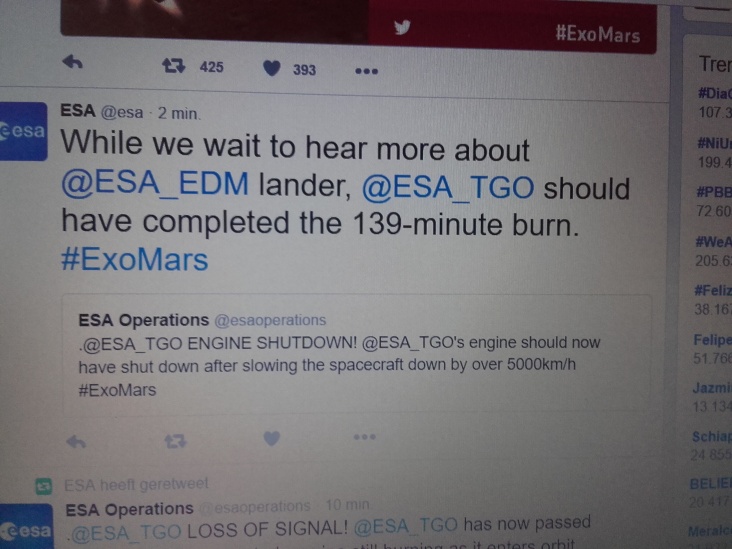


Op dat moment betekende dat nog niks. Een kortdurend signaalverlies was voorzien, maar nu duurde het toch wel erg lang. Gevolg: wachten, nagelbijten en hopen dat er duidelijkheid zou komen.
Aangezien de TGO op dat moment aan de achterkant van Mars was, moesten we wachten tot deze hier achteruit kwam en hopenljk een signaal zou geven.
En ja, daar kwam de grote ontlading: We hadden een signaal. Dus deel 1 was geslaagd. De TGO was in een baan om Mars gebracht.

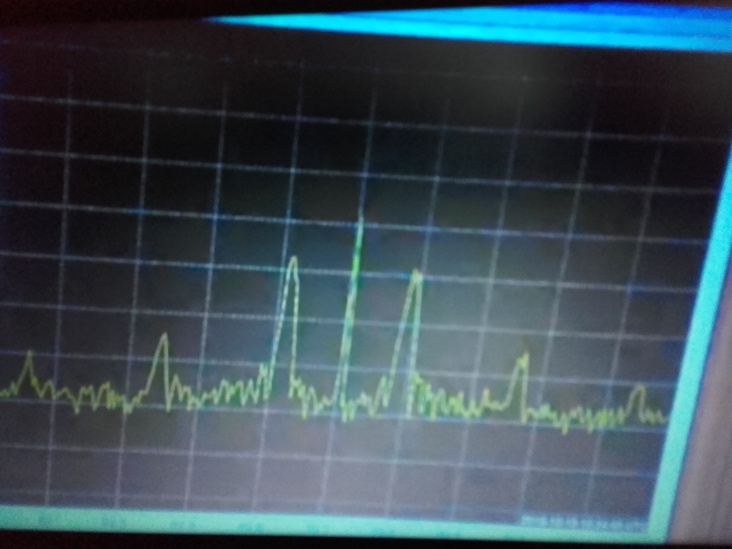
Foto's Joyce.S v.e live uitzending vd ESA
Maar hoe zit het nou met de landing van Schiaparelli? Daar is tot op dit moment nog onduidelijkheid over. Gisteravond was er nog een korte persconferentie, waarin men aankondigde de hele nacht te gaan analiseren en vandaag om 10:00 uur met een nieuwe persconferentie zou komen.
Wellicht weet men straks meer en ik zal dan nog met een nieuwe update komen.
Dus vooralsnog is het nog even wachten en hopen.
So...to be continued | Gewijzigd: 1 februari 2017, 09:33 uur, door Joyce.s
Update: Persconferentie ESA omtrent TGO en Schiaparelli:
De persconferentie werd begonnen met de bevestiging dat de TGO inderdaad in een baan om Mars is. Deze baan zal in de komende tijden nog worden aangepast. Men heeft in de tussentijd 600 megabytes aan data ontvangen. Deze data zullen gebruikt worden voor de missie van 2020.Maar dan de grote vraag: Wat is er met Schiaparelli gebeurd?
Schiaparelli heeft gedurende de landing wel veel data door kunnen geven. Derhalve weet men dat het binnendringen van de Marsatmosfeer goed is verlopen, het hitteschild heeft goed gefunctioneerd. Ook de parachute is opengegaan.
Waar is het dan verkeerd gegaan?
Dat is het moment geweest dat de parachute losgekoppeld is (de data die zijn ontvangen, waren anders dan de verwachtingen waren) en de remthrusters aan hebben moeten gaan. De bevestiging is er dat de thrusters gedurende 3 a 4 seconden aan zijn geweest. Onduidelijk is of ze állemaal aan zijn gegaan. De data van de laatste circa 50 seconden ontbreekt, derhalve is op dit moment ook niet te zeggen of er sprake is geweest van een crashlanding. De analyses hieromtrent zijn nog steeds gaande.Er was dopplerdata aan boord en die was goed tot aan de parachutefase. Er kunnen dus meerdere oorzaken zijn geweest, zoals:
- te hoge snelheid
- te vroege afstoting
- te kort bij het Marsoppervlak. Hierover is echter nog steeds onduidelijkheid.
Tot slot:
Esa is ervan overtuigd dat ze een duidelijk beeld gaan krijgen wat er nou precies gebeurd is in die laatste seconden. Aangezien er veel data is behouden van de "entry" - slechts de laatste seconden zijn verloren gegaan - heeft ESA het volste vertrouwen dat de 2020 missie goed zal verlopen.
Men kijkt terug op een overgrote deel goed verlopen missie en benadrukt dat Schiaparelli een testvoertuig was.
De TGO kan nu aan het werk. Hieronder nog een samenvatting wat de TGO voor ons gaat betekenen.
Onweer-Online/Joyce
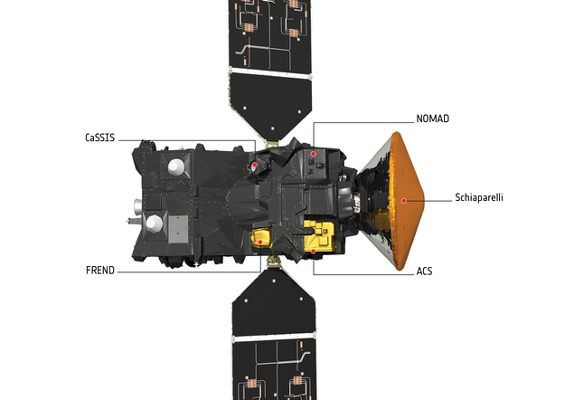
SEARCHING FOR SIGNATURE GASES IN THE MARTIAN ATMOSPHERE
The 2016 ExoMars Trace Gas Orbiter is the first in a series of Mars missions to be undertaken jointly by the two space agencies, ESA and Roscosmos. A key goal of this mission is to gain a better understanding of methane and other atmospheric gases that are present in small concentrations (less than 1% of the atmosphere) but nevertheless could be evidence for possible biological or geological activity.
Investigations with observatories in space and on Earth have demonstrated the presence of small amounts of methane in the Martian atmosphere that has been shown to vary with location and time. Since methane is short-lived on geological time scales, its presence implies the existence of an active, current source of methane. It is not clear, yet, whether the nature of that source is biological or chemical. Organisms on Earth release methane as they digest nutrients. However, other purely geological processes, such as the oxidation of certain minerals, also release methane.
The Trace Gas Orbiter carries a scientific payload capable of addressing this scientific question, namely the detection and characterisation of trace gases in the Martian atmosphere. From its approximately 400-km-altitude science orbit, the instruments onboard the Trace Gas Orbiter will be deployed to detect a wide range of atmospheric trace gases (such as methane, water vapour, nitrogen oxides, acetylene), with an improved accuracy of three orders of magnitude compared to previous measurements.
The Trace Gas Orbiter will monitor seasonal changes in the atmosphere’s composition and temperature in order to create and refine detailed atmospheric models. Its instruments will also map the subsurface hydrogen to a depth of a metre, with improved spatial resolution compared with previous measurements. This could reveal deposits of water-ice hidden just below the surface, which, along with locations identified as sources of the trace gases, could influence the choice of landing sites of future missions.
COMMUNICATING ON MARS
The Trace Gas Orbiter carries the Entry, Descent and landing demonstrator Module (EDM), known as Schiaparelli, on the journey from Earth towards Mars and, as it approaches the planet, deploys it for entering the Martian atmosphere on its way to land on the surface of the planet. After deployment, the Orbiter will monitor the UHF transmission from Schiaparelli from its coasting to Mars until its landing on the Red Planet. It will also facilitate the real-time transmission to Earth of the most important data measured by Schiaparelli.
Scientific investigations will take top priority until the second mission in the ExoMars programme begins, with the arrival of the ExoMars rover in 2021. At that stage the Orbiter will become a valuable Mars telecommunications asset, providing communication services to the Rover operating on the surface of Mars. The Orbiter will act as a data relay centre for sending commands to the rover and downloading data to Earth through the ESA space communications network.
Bron: http://exploration.esa.int/mars/46475-trace-gas-orbiter/
Mars spacecraft 'was destroyed in crash-landing'
A spacecraft sent to sent to beam back data from Mars appears to have been destroyed after crash-landing to the surface of the red planet, the team behind the mission has said.The Schiaparelli probe had travelled for 365 million miles to reach Mars in a new push to gather data - including evidence of possible life on the planet.
But it failed at the final hurdle after apparently losing control as it entered the martian atmosphere, said the European Space Agency (ESA).
New images taken by a NASA Mars orbiter indicate that the lander was destroyed after free-falling between two and four kilometres onto the planet's surface, it said.
The pictures show a fuzzy dark patch, around 15 by 40 metres in size, about 1 km north of the lander's parachute.
ESA scientists believe it is impact marks caused by the lander as it crash-landed on the planet. They said that there might also have been an explosion on impact as the lander's tanks were still full.
The Schiaparelli probe had been missing and its status unknown since scientists lost contact with it 50 seconds before its expected landing time on Friday afternoon.
Its loss will be especially bitter as it had marked Europe's first attempt to place a lander on the planet since the the Beagle 2's "heroic failure" more than a decade ago.
The earlier Beagle probe had landed - but immediately afterwards vanished after its solar panels failed to deploy.
The Schiaparelli probe had been intended to test technology for a later rover planned for 2020.
However, the mission's larger mothership had successfully swung into orbit around Mars, where it will carry out tests to detect gases such as methane which could indicate the presence of life.
Bron: itv.com | Gewijzigd: 21 oktober 2016, 20:01 uur, door Justin
NASA’s Mars Reconnaissance Orbiter ziet Schiaparelli´s landingsplaats:

Mars Reconnaissance Orbiter view of Schiaparelli landing site. Photo ESA
21 October 2016
NASA’s Mars Reconnaissance Orbiter has identified new markings on the surface of the Red Planet that are believed to be related to ESA’s ExoMars Schiaparelli entry, descent and landing technology demonstrator module.
Schiaparelli entered the martian atmosphere at 14:42 GMT on 19 October for its 6-minute descent to the surface, but contact was lost shortly before expected touchdown. Data recorded by its mothership, the Trace Gas Orbiter, are currently being analysed to understand what happened during the descent sequence.
In the meantime, the low-resolution CTX camera on-board the Mars Reconnaissance Orbiter (MRO) took pictures of the expected touchdown site in Meridiani Planum on 20 October as part of a planned imaging campaign.
The image released today has a resolution of 6 metres per pixel and shows two new features on the surface when compared to an image from the same camera taken in May this year.

Schiaparelli landing site. Photo ESA
One of the features is bright and can be associated with the 12-m diameter parachute used in the second stage of Schiaparelli’s descent, after the initial heat shield entry. The parachute and the associated back shield were released from Schiaparelli prior to the final phase, during which its nine thrusters should have slowed it to a standstill just above the surface.
The other new feature is a fuzzy dark patch roughly 15 x 40 metres in size and about 1 km north of the parachute. This is interpreted as arising from the impact of the Schiaparelli module itself following a much longer free fall than planned, after the thrusters were switched off prematurely.
Estimates are that Schiaparelli dropped from a height of between 2 and 4 kilometres, therefore impacting at a considerable speed, greater than 300 km/h. The relatively large size of the feature would then arise from disturbed surface material. It is also possible that the lander exploded on impact, as its thruster propellant tanks were likely still full. These preliminary interpretations will be refined following further analysis.
A closer look at these features will be taken next week with HiRISE, the highest-resolution camera onboard MRO. These images may also reveal the location of the front heat shield, dropped at higher altitude.

MRO image of Schiaparelli – before. Photo ESA
Since the module’s descent trajectory was observed from three different locations, the teams are confident that they will be able to reconstruct the chain of events with great accuracy. The exact mode of anomaly onboard Schiaparelli is still under investigation.
The two new features are located at 353.79 degrees east longitude, 2.07 degrees south latitude on Mars. The position of the dark mark shows that Schiaparelli impacted approximately 5.4 km west of its intended landing point, well within the nominal 100 x 15 km landing ellipse.
Meanwhile, the teams continue to decode the data extracted from the recording of Schiaparelli descent signals recorded by the ExoMars TGO in order to establish correlations with the measurements made with the Giant Metrewave Radio Telescope (GMRT), an experimental telescope array located near Pune, India, and with ESA’s Mars Express from orbit.
A substantial amount of extremely valuable Schiaparelli engineering data were relayed back to the TGO during the descent and is being analysed by engineers day and night.

MRO image of Schiaparelli – after photo ESA
The ExoMars TGO orbiter is currently on a 101 000 km x 3691 km orbit (with respect to the centre of the planet) with a period of 4.2 days, well within the planned initial orbit. The spacecraft is working very well and will take science calibration data during two orbits in November 2016.
It will then be ready for the planned aerobraking manoeuvres starting in March 2017 and continuing for most of the year, bringing it into a 400-km altitude circular orbit around Mars.
The TGO will then begin its primary science mission to study the atmosphere of Mars in search of possible indications of life below the surface, and to act as a telecommunications relay station for the ExoMars 2020 rover and other landed assets.
Bron: http://www.esa.int/Our_Activities/Space_Science/ExoMars/Mars_Reconnaissance_Orbiter_views_Schiaparelli_landing_site
| Gewijzigd: 1 februari 2017, 09:34 uur, door Joyce.s
Marslander dacht er al te zijn en stortte neer
De Marslander Schiaparelli is waarschijnlijk neergestort door een rekenfout. De lander dacht dat de oppervlakte van de planeet allang was bereikt, terwijl er nog 3,7 kilometer te gaan was. Dat blijkt uit onderzoek van de Europese ruimtevaartorganisatie ESA.
De problemen ontstonden kort nadat de parachute van de Marslander was geactiveerd. Dat gebeurde zoals gepland op 12 kilometer afstand van de planeet. De lander ging op dat moment 1730 kilometer per uur.
Los van parachute
De meetapparatuur aan boord gaf vlak voor de landing een negatieve hoogteschatting door. Het systeem raakte in de war en dacht dat de planeet al was bereikt. De lander koppelde zichzelf los van de parachute en de remmotoren sloegen aan. Schiaparelli is daarna te pletter gestort en geëxplodeerd.
De directeur van ESA benadrukt dat het gaat om voorlopige conclusies. Pas begin 2017 zal naar verwachting duidelijk zijn wat er precies is gebeurd.
De landing van het Schiaparelli-laboratorium was een experiment, bedoeld om de technologie te testen. Europa wil rond 2020 een onbemande rijdende verkenner naar Mars brengen.
Bron: http://nos.nl/artikel/2144761-marslander-dacht-er-al-te-zijn-en-stortte-neer.html | Gewijzigd: 1 februari 2017, 09:35 uur, door Joyce.s

 Woensdag landt Schiaparelli van de ESA op Mars (live)
Woensdag landt Schiaparelli van de ESA op Mars (live)


